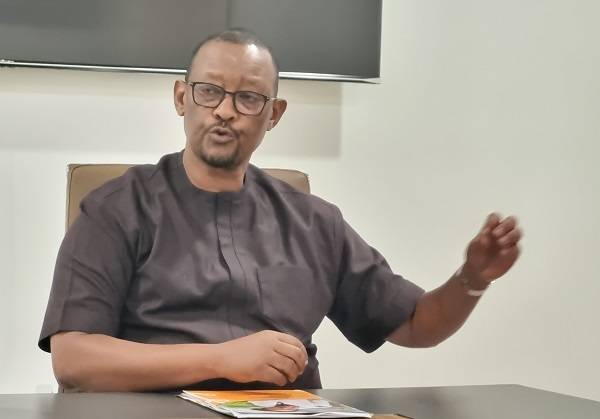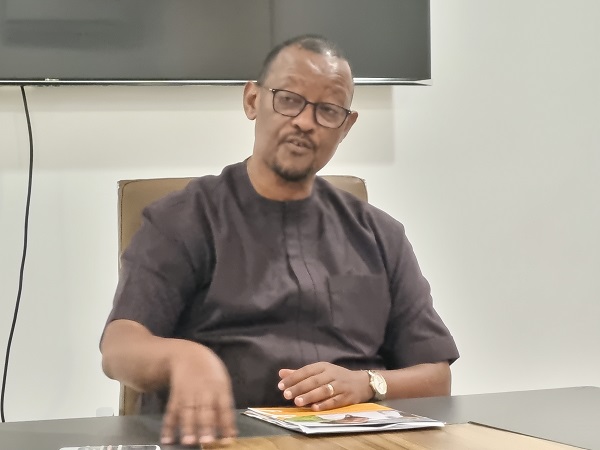
The executive director of the African Agricultural Technology Foundation (AATF), Dr. Canisius Kanangire, spoke with a select group of journalists in Abuja about the foundation’s new strategy for agriculture in Africa and why he thinks it may hold the key to the next frontier in agricultural biotechnology and food security on the continent.
The African Agricultural Technology Foundation (AATF) has recently launched a new strategic framework for 2023-2027. Why do you think the core objectives of this strategy and the achievements of the previous strategy are worth exploring?
Agriculture in Africa faces numerous challenges, including those related to climate change. I often refer to it as a climate crisis because many countries are truly in crisis. Droughts occur, and when the rains finally arrive, they come in a disorganized manner, causing more destruction than construction. Climate change is one of the issues, but we also know that crops are being devastated by various pests and diseases, including some previously unknown on the African continent in the past five years. For instance, the Fall Armyworm (FAW) can nearly destroy maize plantations, and the stem borer, such as the Maruca, is also a significant concern. These challenges can be addressed with various technologies. However, we recognize that there are additional factors that need to be combined to ensure agricultural success. Consequently, we have developed successive strategies. The strategy we launched two days ago primarily focuses on providing technological solutions to address these challenges.
Our first major objective is to continue diversifying our technologies and develop the next generation of existing technologies that we have introduced to farms. This entails introducing seed varieties that can withstand drought and technologies that can be translated into seeds to combat pests like the stem borer, which can devastate cowpea plantations, especially in Nigeria. We also aim to address the issue of weeds, which constantly frustrate farmers. These are just a few examples of the technologies we aim to introduce. By doing so, we strive to provide firm and robust solutions to the identified issues, as well as address emerging challenges that arise daily.
The second objective is to enhance the commercialization and widespread adoption of existing technologies. Although we already have technologies such as hybrids that are more productive and improved seeds that can withstand drought or resist pests, their penetration into the population remains challenging. Access to these technologies is limited, and many people are still unaware of their existence. Therefore, we aim to scale up the commercialization efforts so that these products can reach as many people as possible. This will enable us to create the desired impact and foster prosperity by expanding access and opening up markets. However, we must acknowledge that current policies in the African continent are not conducive to the necessary transformation. This inconsistency in policies hinders progress and is something I would like to address to my fellow decision-makers and policymakers at various levels.
By aligning our strategies with the core objectives of diversifying technologies, scaling up commercialization, and addressing policy inconsistencies, we aim to bring about positive change and contribute to the transformation of agriculture in Africa.
We have the commitment by our head of states that we need to transform agriculture into an economically sound sector. But when it comes down to having those policies and strategies which will enable us to implement that commitment, then we start having very slow motion at some time pulling in different directions. So, I think that policies and regulatory framework have been quite slow in ensuring that we have the enabling environment that we need, and because of that, again, our third key objective is to ensure that the enabling environment is functional and conducive to the changes that we need.
In addition to those three major objectives, which are called strategic objectives, we have cross-cutting priorities that need to be mainstreamed in everything we do. The first priority is climate change. We need to incorporate climate change considerations into our agricultural practices. The second priority is gender. We must provide women and youth with access to agribusiness factors so that they can contribute fully to agricultural productivity.
Another important priority is nutrition. While we have been focused on food security, we also need to address nutrition by ensuring that our diets are nutritious in terms of micronutrients, vitamins, and other components. Nutrition should be integrated into many projects and initiatives.
The last cross-cutting priority is knowledge and evidence, which is connected to data. If we want to convince others to adopt the technologies we are bringing, we need to provide evidence of their impact. We should quantify the benefits these technologies can bring to the farm. This information can then be used to influence policies, investment decisions, and changes in the mindset of farmers.
As we move towards the era of artificial intelligence and other digital tools, data becomes critical. We need to be more scientific in our approach, quantifying our production and expenditures. This data will help us assess the balance and make informed decisions.
To summarize, the four cross-cutting priorities that we integrate into the system are climate change, gender, nutrition, and knowledge and evidence. By addressing these priorities, we can create a more sustainable and productive agricultural sector.

How far has AATF gone in getting African governments to embrace biotechnology and its tools to boost agricultural productivity?
Biotechnology is one of the key areas of technological change that we need to bring to Africa. It involves identifying the needs of farmers on the African continent and discussing them with government authorities in each country. AATF has been successful in scouting and negotiating the right technologies to be transferred to our governance. However, it is also crucial to have policies in place that allow the introduction of biotechnology products to consumers in each country.
In terms of regulatory frameworks, AATF has worked with various countries, including Nigeria, to improve and implement national biosafety laws. This is necessary to establish the right institutions and regulatory frameworks for biosafety. Progress has been made in several countries, although there is still room for improvement and expediting the process. It is important for countries to be convinced of the benefits before embracing these technologies, and AATF respects their sovereignty in making informed decisions.
In Nigeria, we have successfully introduced Pod Borer Resistant (PBR) cowpea, which is resistant to Maruca vitrata. This has significantly increased productivity and reduced the need for excessive insecticide sprays, benefiting the economy, environment, and health of farmers. Additionally, Nigeria has embraced TELA Maize, an insect-resistant variety that is progressing well. Following Nigeria’s success, Ghana has released PBR cowpea, and we expect it to reach farmers soon. We also hope for progress in Burkina Faso with TELA Maize. Biotechnology products, including GMOs, are already being planted in South Africa, and soon Ethiopia, Kenya, and Mozambique will follow suit. There are also ongoing projects on genome editing, showing promising developments.
Overall, progress is being made in biotechnology adoption, and we are encouraged by the successes we have witnessed. AATF remains committed to promoting biotechnology as a means to enhance agricultural productivity in Africa and will continue to learn from our experiences and build on our achievements.
What role is AATF playing to avail African farmers the opportunity of participating in this new phase of farming experience? There is a lot of talk about NextGen products.
AATF is working with farmers, the private sector, and the government to manage the introduction of NextGen products in Africa. They are focusing on developing varieties of crops that resist droughts, insects, and other challenges. For example, they have developed a variety of cowpea that resists insects during growth and development, as well as another variety that resists insect damage during storage. They are also working on the next generation of cowpea with storage weevil resistance. AATF is collaborating with partners, funders, and institutions at the country level to involve farmers and the government in this process. In Nigeria, they are proud to work with the Institute for Agricultural Research (IAR) at the Ahmadu Bello University, Zaria, Kaduna State to customise products to the country’s needs and ensure sustainability.
Is AATF doing anything to strengthen the seed system in the West African sub-region?
Yes, AATF recognises the importance of strengthening the seed system to achieve the commercialization and scale of impact desired from biotech and technology products. They are actively working on strengthening the seed system from foundation seed to certified seed. In Eastern and Southern African countries, they established the Ecobasic Seed Company five years ago, which has supported the production of foundation seeds, particularly for maize in South Africa, Zambia and Kenya. In Nigeria, they established Ecobasic two years ago to develop foundation seeds for cowpea and maize, in collaboration with IAR. The goal is to meet the demand for improved seeds from all farmers in Nigeria. Ecobasic is also expanding to serve West Africa, with Ghana joining and Burkina Faso expected to participate soon. The company aims to build the capacity of seed companies and certified seed producers. Although the seed system is still young, Ecobasic has made significant progress, producing over 40 metric tons of seeds in its first year and continuing to improve. AATF is committed to ensuring a strong and efficient seed system to meet the demand for new technologies across multiple African countries.
Is there still hope for Africa to reach the target of ending hunger by 2025, as set by the AU’s Malabo Declaration?
We are far from ending hunger and poverty in Africa, but there has been significant progress. Some countries have even implemented most of the targets set by the Malabo Declaration. The scorecard of the African continent in agriculture, which is evaluated every two years, shows that while more can be done, Africa has been progressively moving forward. However, we need to accelerate the pace of transformation and adopt the necessary changes to revolutionize the agricultural sector. Instead of following the ordinary path, we should leapfrog towards the desired goals. Over the next two years, we have the opportunity to make further progress and establish a stronger foundation for evaluating the past 25 years and making new commitments based on the lessons learned and the commitments made at various summits and high-level meetings. I urge decision-makers, policymakers, and the private sector to use this time to expedite the necessary transformation in agriculture and lay the groundwork for the next 20 years. It is crucial to recognize that unless we develop agriculture as an economic sector, the overall development of Africa will be challenging to achieve. With more than 60 per cent of our people engaged in agriculture, empowering women and youth and providing them with the right technology, knowledge, and access to production factors are essential. This appeal is directed to the leaders of the continent.

What is the situation with the PBR Cowpea crop in Burkina Faso?
The situation with the PBR Cowpea crop in Burkina Faso is promising. While there may have been some slowing down factors in recent years, the new leadership in Burkina Faso is very open and willing to embrace this technology. AATF is determined to work closely with them and provide the necessary support. It is expected that soon there will be good news from Burkina Faso regarding the adoption of PBR Cowpea. In addition, efforts are underway to harmonize policies and regulations within the sub-region, specifically in West Africa. Discussions will take place with ECOWAS leadership to explore the possibility of harmonization, where if a seed is approved by two or three countries, it can be extended to the entire economic region. This would facilitate the adoption of PBR Cowpea in other West African countries after Burkina Faso, creating a seamless process. Another important effort being made is to ensure consistency and coherence among policies. This includes integrating agriculture into the new initiative of intercontinental trade, allowing agricultural products, technologies, and seeds to cross borders without hindrance. The harmonisation of policies is a key focus in discussions with various bodies such as the African Union and AUDA-NEPAD. The goal is to register success in one country or region and easily adopt it in others. Additionally, there is a need to streamline the deregulation process for products. Instead of conducting redundant tests in multiple countries, there should be trust in the institutions that have already conducted thorough testing. The transportability of data is being worked on to facilitate adoption by focusing on specific agroecological zones rather than repeating the entire process. The aim is to save time and resources while still ensuring the suitability of the technology in different contexts.
Is AATF implementing any strategy to fast-track or enhance the rate of mechanisation in Africa?
Yes, AATF is implementing strategies to fast-track and enhance the rate of mechanisation in Africa. Recognizing the crucial role of mechanisation in achieving food security and prosperity through agriculture, AATF has been actively encouraging mechanisation in various ways. A decade ago, AATF piloted the Cassava Mechanisation and Agro-processing Project (CAMAP) in Nigeria, Zambia, Uganda, and Tanzania. The aim was to demonstrate the potential of mechanisation to improve agricultural practices and productivity. The results were significant, with mechanisation increasing productivity from seven to nine tonnes per hectare to 25 times per hectare or more. Mechanisation not only allowed farmers to cultivate larger areas but also improved agronomic practices and reduced the time spent on the farm, benefiting the entire family.
Building on the success of CAMAP, AATF has continued its mechanisation initiatives in Nigeria through a company called Agridrive. Agridrive provides mechanisation services to farmers, including smallholder farmers who cannot afford their own tractors. The goal is to show that such services can positively impact the lives of farmers and encourage the private sector to invest in mechanisation. Agridrive integrates various services, such as land preparation, planting, harvesting, and even processing. The processing component allows farmers to convert their produce, like cassava, into flour for human or animal consumption, reducing post-harvest losses. By considering the entire value chain, AATF aims to stimulate the development of agro-processors and small businesses around the cassava value chain, further transforming the lives of farmers.
To further enhance mechanisation efforts, AATF seeks to provide successful examples to the private sector and engage them in supporting mechanisation. This involves presenting demands and proposals to philanthropists, rich individuals, and other stakeholders who have the resources to invest in producing agricultural equipment. AATF emphasizes the importance of reducing the high costs associated with mechanisation equipment. By garnering support from the private sector and reducing equipment costs, significant progress can be made in advancing mechanisation in Africa.


